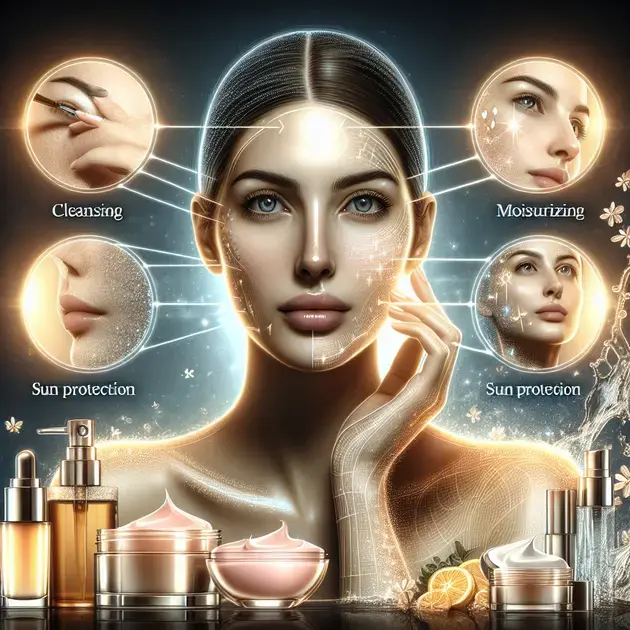
Are you looking to establish a skin routine step that will provide you with a flawless skincare regimen? Look no further. In this comprehensive guide, we will walk you through the essential steps to achieve and maintain healthy, glowing skin.
With the current beauty industry trends focusing on natural and clean skincare products, it’s important to understand the importance of each skin routine step. From cleansing to moisturizing, each step plays a crucial role in ensuring your skin remains healthy and radiant.

Establishing Your Skincare Foundation
Establishing a solid skincare routine is crucial for maintaining healthy and radiant skin. To start, it is essential to determine your skin type by consulting with a dermatologist or using online skin analysis tools like SkinVision. Once you have identified your skin type, you can choose the right products tailored to your specific needs.
The next step in establishing your skincare foundation is cleansing. Begin by removing makeup and impurities from your skin using a gentle cleanser. Look for products with ingredients like salicylic acid or glycolic acid for exfoliation and deep cleaning. Brands like CleanserCo offer a wide range of cleansers suitable for all skin types.
After cleansing, it’s important to incorporate a toner into your routine. Toners help to balance the skin’s pH levels and prepare it for the next steps of your regimen. Brands like ToneMe provide toners infused with natural ingredients beneficial for different skin concerns.
Following toning, apply a serum packed with antioxidants and vitamins to target specific skin issues. Brands like SerumGenius offer serums that address concerns such as aging, hyperpigmentation, and dullness, providing targeted care for your skin.
Complete your skincare foundation with a moisturizer suitable for your skin type. Whether you have dry, oily, combination, or sensitive skin, it’s essential to hydrate and protect your skin with a moisturizer. Look for products from reputable brands like MoistureBoost that cater to diverse skin needs.
The Importance of Cleansing in Your Skin Routine
Cleansing is a vital step in any skincare routine as it helps to remove dirt, oil, and impurities that can clog pores and lead to breakouts. Start by selecting a cleanser that matches your skin type—whether it’s dry, oily, combination, or sensitive. Websites like BestCleansers provide reviews and recommendations for top-rated cleansers in the market.
When cleansing your skin, massage the cleanser gently in circular motions to ensure thorough cleansing without causing irritation. Pay special attention to areas prone to oiliness or congestion, such as the T-zone. Using a gentle exfoliating cleanser once or twice a week can help unclog pores and improve skin texture.
Consider double cleansing if you wear makeup or sunscreen regularly. Start with an oil-based cleanser to break down makeup and follow up with a water-based cleanser to remove any residue. This method ensures that your skin is clean and ready to absorb the benefits of your skincare products.
For those with acne-prone skin, incorporating a cleanser containing salicylic acid or benzoyl peroxide can help prevent breakouts and reduce inflammation. Brands like ClearSkin offer specialized cleansers for acne-prone skin to promote clearer and healthier skin.
Remember to cleanse your skin both in the morning and evening to maintain a clean and healthy complexion. Consistency in cleansing is key to achieving clear, radiant skin and preventing common skin issues.
Achieving Radiant Skin Through Proper Moisturizing
Proper moisturizing is essential for achieving radiant skin and maintaining its health and vitality. Start by choosing a moisturizer suited to your skin type and concerns. Websites like SkinTypeFinder offer quizzes to help you identify the most suitable moisturizer for your skin.
When applying moisturizer, use gentle upward strokes to promote circulation and prevent pulling or tugging on the skin. Ensure you cover the entire face and neck to provide hydration and protection to all areas. Pay extra attention to dry or rough patches to restore smoothness and elasticity.
Consider incorporating a night cream into your routine to provide extra hydration and nourishment while you sleep. Night creams are often richer in texture and contain ingredients that promote cell renewal and repair, leaving your skin rejuvenated and refreshed in the morning.
For those with oily skin, opt for oil-free or non-comedogenic moisturizers to prevent clogged pores and breakouts. Look for lightweight formulations that hydrate the skin without leaving a greasy residue. Brands like OilControl offer moisturizers specifically designed for oily skin types.
Don’t forget to apply sunscreen as the final step in your daytime skincare routine. Sunscreen helps protect your skin from harmful UV rays that can cause premature aging, dark spots, and skin cancer. Choose a broad-spectrum sunscreen with an SPF of 30 or higher and reapply throughout the day for continuous protection.

Developing an Effective Exfoliation Strategy
When looking to develop an effective exfoliation strategy, it’s important to understand the different types of exfoliants available in the market. Physical exfoliants, such as scrubs, work by physically removing dead skin cells from the surface of the skin. On the other hand, chemical exfoliants, like AHAs and BHAs, penetrate the skin to dissolve the bonds between dead skin cells, resulting in smoother and brighter skin.
It’s crucial to consider your skin type when choosing an exfoliant. Those with sensitive skin may benefit more from gentle exfoliants, while individuals with oily skin might require stronger exfoliation. Additionally, frequency plays a key role in an exfoliation strategy. Over-exfoliating can lead to irritation and damaged skin barrier, so it’s recommended to start exfoliating 1-3 times a week and adjust as needed.
Another important aspect of developing an effective exfoliation strategy is to always follow up with proper hydration and sun protection. Exfoliation can make the skin more sensitive to the sun, so applying SPF daily is essential to prevent sun damage and premature aging. Incorporating hydrating products, such as serums and moisturizers, can help replenish the skin’s moisture barrier after exfoliation.
In conclusion, a well-rounded exfoliation strategy involves understanding the different types of exfoliants, considering your skin type, regulating the frequency of exfoliation, and maintaining proper hydration and sun protection. By following these steps, you can achieve smoother, brighter, and healthier-looking skin.
The Impact of Sun Protection on Skin Health
Sun protection plays a crucial role in maintaining skin health and preventing various skin issues. Prolonged exposure to harmful UV rays can lead to premature aging, dark spots, and even skin cancer. Using sunscreen with a high SPF not only protects the skin from these damages but also helps in preserving its overall health and appearance.
Aside from sunscreen, other sun protection methods like wearing protective clothing, hats, and seeking shade during peak sun hours can further shield the skin from UV damage. It’s important to apply sunscreen generously and reapply it throughout the day, especially after swimming or sweating, to ensure continuous protection.
When incorporating sun protection into your skincare routine, consider using products that offer both UV protection and skincare benefits. Many moisturizers, serums, and makeup products now come with built-in SPF, making it easier to stay protected while addressing other skin concerns like hydration and anti-aging.
In summary, prioritizing sun protection in your daily skincare routine is essential for maintaining skin health, preventing sun damage, and preserving a youthful complexion. By being proactive in protecting your skin from the sun’s harmful rays, you can enjoy healthy and radiant skin in the long run.
Unveiling the Power of Serums in Skincare
Serums have gained popularity in the skincare industry for their potent formulations and targeted benefits. These lightweight, fast-absorbing liquids are packed with active ingredients that can address specific skin concerns, such as hydration, anti-aging, brightening, and acne-fighting. Including a serum in your skincare routine can provide an extra boost of nourishment and treatment for your skin.
One of the key advantages of serums is their high concentration of active ingredients, allowing for better penetration into the skin and more noticeable results. Whether you’re looking to improve skin texture, reduce fine lines, or even out skin tone, there’s a serum tailored to meet your skincare needs.
When choosing a serum, it’s important to consider your skin type and concerns to select the most suitable formula. For example, individuals with dry skin may benefit from hydrating serums containing ingredients like hyaluronic acid, while those with acne-prone skin can opt for serums with salicylic acid or niacinamide to combat breakouts.
To maximize the effectiveness of serums, apply them onto clean, toned skin before moisturizing. This allows the active ingredients to penetrate deeply and work their magic on your skin. With consistent use, serums can help improve the overall health and appearance of your skin, leaving it looking radiant and rejuvenated.
Conclusion
Developing an effective exfoliation strategy requires a comprehensive understanding of the available exfoliants and their mechanisms. Whether opting for physical scrubs or chemical exfoliants like AHAs and BHAs, tailoring the choice based on skin type is vital. Sensitive skin benefits from gentler options, while oily skin may require stronger exfoliation. Proper frequency, starting at 1-3 times a week, is crucial to prevent skin irritation and damage.
Furthermore, following up exfoliation with adequate hydration and sun protection is paramount. While exfoliation enhances skin sensitivity to the sun, daily SPF application is essential for safeguarding against sun damage and premature aging. Incorporating hydrating products like serums and moisturizers post-exfoliation helps replenish the skin’s moisture barrier, promoting overall skin health.
Transitioning to the impact of sun protection on skin health emphasizes its critical role in preventing various skin issues induced by UV damage. Sunscreen with a high SPF not only shields against premature aging, dark spots, and skin cancer but also preserves the skin’s vitality and appearance. Additional protective measures such as wearing UV-protective clothing and hats, seeking shade, and reapplying sunscreen throughout the day reinforce skin defense against UV rays.
Lastly, embracing the power of serums in skincare highlights these potent formulations’ targeted benefits and effectiveness. With high concentrations of active ingredients, serums penetrate deeply into the skin, yielding noticeable improvements in skin texture, fine lines, and skin tone. Choosing the right serum based on skin type and concerns, whether for hydration, anti-aging, or acne-fighting, complements skincare routines and enhances overall skin health, leaving the skin radiant and rejuvenated.